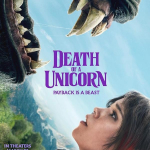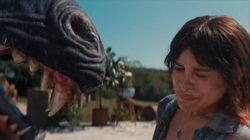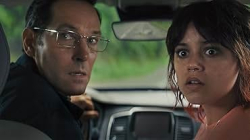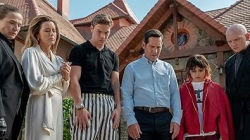A Journey into the Mythical Abyss
I found myself unexpectedly drawn into the enigmatic world of Death of a Unicorn Movie. From the very opening scene, I sensed that this would be no ordinary cinematic experience. The film effortlessly merges the fantastical with the surreal, creating a narrative that is equal parts mesmerizing and mysterious. As I sat in front of the screen, I felt as if I had been transported to a realm where dreams and reality coexist in a delicate balance. The ancient wistfulness and rebellious modernity intertwined throughout the film resonated with my innermost thoughts, stirring a cascade of memories and emotions that I had not anticipated.
My first encounter with the film’s title evoked a personal blend of curiosity and trepidation. I was intrigued by the irony and contradictions in the name itself. The phrase suggested both beauty and decay, life and impending demise, prompting me to wonder how the narrative would navigate these dualities. Once the film unfurled its layered storytelling, I found myself immersed in profound dialogues and unexpected visual allegories that challenged my perceptions of myth and morality.
Mesmerizing Visual Landscapes
One aspect of Death of a Unicorn Movie that immediately captivated me was the visual artistry. Each frame appears to have been meticulously painted with a blend of vivid colors and muted tones that seem to breathe life into both the characters and the shadowy landscapes they inhabit. The juxtaposition of fantastical elements with realistic textures provided me with a rare glimpse into a world where the boundaries of nature and imagination blur seamlessly.
As I continued watching, I observed how every scene was carefully composed to evoke a sense of wonder and introspection. The cinematography carried me on an unanticipated journey through enchanted forests, dilapidated urban environments, and surreal dreamscapes. The camera’s fluidity and the deliberate pace imbued every moment with a sense of purpose and urgency, drawing me deeper into the film’s layered narrative. I marveled at the way the artwork on the screen enveloped me in its atmosphere, challenging me to perceive beauty in decay and hope in despair.
The Enigma of the Plot
The narrative structure of Death of a Unicorn Movie is a labyrinth of symbolism and intricate storytelling. As I watched, I became increasingly aware of the film's refusal to be pigeonholed into traditional genres. Instead, it embraces an audacious approach that oscillates between allegorical romance, existential drama, and elements of dark fantasy. Every twist and turn of the plot was presented as an invitation to question the nature of existence and the inevitability of transformation.
The film’s storyline challenges the viewer to piece together seemingly disparate elements into a cohesive tapestry of meaning. I found myself consciously dissecting every dialogue, every glance, and every silent moment, attempting to uncover hidden layers that might reveal the film’s deeper message about the cycle of life, the loss of innocence, and the transient nature of beauty in an ever-changing world. This process, at times overwhelming yet deeply satisfying, allowed me to interact with the narrative in a uniquely personal way that left a lasting impression.
The Pulse of the Soundtrack
The movie’s soundtrack works like an ethereal undercurrent that guides the audience through its mystical tale. I was pleasantly surprised by how harmoniously the orchestral melodies, ambient tones, and haunting vocalizations synchronized with the visual narrative. Each musical note was infused with emotion, acting as both a storyteller and a silent observer to the unfolding drama on screen.
During the quieter moments, the music provided a delicate, almost imperceptible commentary that enriched my experience. It seemed to speak directly to emotions that were otherwise left unexpressed by the actors. In moments of tension, the ever-present hum of the background score heightened my anticipation and deepened my engagement with the unfolding mystery. I found my senses sharpened by the intricate interplay between sound and image, which seemed to echo the film’s constant dance between reality and fantasy.
Performances of Subtle Brilliance
One of the most striking features of Death of a Unicorn Movie is the compelling performances delivered by its cast. The protagonists are not overly dramatized but are instead portrayed with a deliberate subtlety that invites introspection. Each actor seems to serve as an extension of the narrative itself, conveying complex emotions with a measured intensity that left me both enchanted and introspective.
I particularly appreciated moments when the characters communicated through mere expressions or small gestures rather than verbose dialogue. There were instances when an actor’s inward gaze or a fleeting smile carried the weight of profound loss or overwhelming hope. These moments, immersed in quiet intensity, allowed me to connect authentically with each character's inner journey. Their understated portrayals lent the film a sense of gravity and sincerity, transforming the fantastical into something palpably human.
A Symphony of Symbolism and Allegory
The film is replete with symbolism that interweaves cultural myth with contemporary reflections. I was struck by how traditional mythical elements, such as the titular unicorn, were reimagined in a narrative framework that challenged conventional lore. Instead of presenting myth as a relic of the past, the film positions it as a living, breathing entity that interacts dynamically with modern themes of love, loss, and the passage of time.
One memorable scene featured the unicorn in a light both ethereal and sorrowful, evoking a sense of noble tragedy. I interpreted this as a metaphor for the ephemeral nature of beauty and innocence in a world dominated by relentless change. The narrative’s layered intertextual references called to mind literature, art, and ancient legends, enticing me to explore connections with my own personal journey. Every symbolic gesture, every allegorical moment pushed me to reconsider my understanding of myth as not merely fantastical, but as a profound commentary on the human condition.
The Nuances of Cinematic Direction
The director of Death of a Unicorn Movie demonstrates a mastery of visual storytelling that is rarely seen in contemporary films. I was particularly impressed by the director’s ability to invite viewers into a narrative without straightforward exposition. The film is constructed in a manner that feels both spontaneous and meticulously planned, allowing each scene to breathe on its own while also contributing to the overall mosaic of the story.
Throughout the viewing experience, I found that the deliberate pacing and the measured buildup of tension allowed each plot twist to resonate more deeply with my emotions. The director’s choice to intersperse moments of high drama with periods of quiet reflection created a rhythm that was as unpredictable as it was captivating. I felt as if I were navigating an intricate dance where every movement was visually and emotionally significant, encouraging me to linger on each detail long after the scene had passed.
Artistry in Costume and Set Design
In Death of a Unicorn Movie, every element of costume and set design seems to have been crafted to perfection. I was astounded by how the costumes not only complemented the narrative but also contributed substantially to the film’s overall thematic fabric. The garments worn by the characters were emblematic of their inner worlds, each piece telling its own story of transformation and identity. Rich textures, unexpected color palettes, and intricate patterns merged to create an immersive visual experience that captivated my attention.
The sets themselves ranged from the opulent to the decaying, producing a visual spectrum that perfectly matched the dual nature of the film’s themes. Whether I was witnessing opulent ballrooms lit by flickering candelabras or wandering through abandoned landscapes that harked back to forgotten eras, I felt as if every visual element was painstakingly chosen. The physical spaces portrayed on screen were imbued with a sense of history and latent emotion, evoking a feeling of being in a living museum where the passage of time was palpable in every crack and crevice.
Complex Emotional Currents Unleashed
One of the most engaging aspects for me was the emotional depth that permeated every scene. Death of a Unicorn Movie is not simply a story to be watched; it is an emotional odyssey that invites me to confront my own vulnerabilities and inner conflicts. The film manages to evoke an array of feelings ranging from melancholy and introspection to bursts of uncontrollable passion and ephemeral euphoria.
There were moments when silence spoke louder than words, and the unspoken tension between characters resonated with raw, unfiltered emotion. I experienced an almost cathartic release as the film drew me into its emotional vortex. Each emotional nuance was presented with a clarity that cut through the pretense of a purely fantastical narrative, grounding me in the reality of the human experience. The interplay between personal loss and universal hope was felt deeply, as though the film had tapped into the collective heartbeat of all who have ever experienced profound change.
Intellectual Undertakings and Narrative Layers
I was continually intrigued by how the film encouraged me to engage intellectually with its narrative. Death of a Unicorn Movie does not shy away from complex themes; rather, it immerses the viewer in a labyrinth of ideas that span existential musings, philosophical debates, and introspective self-discovery. Every conversation, every symbolic gesture in the film prompted me to re-examine my own thoughts and beliefs about destiny, love, and the inherent beauty of impermanence.
The narrative structure is deliberately non-linear, inviting me to piece together fragmented memories, historical allusions, and futuristic warnings within a unified framework of artistic expression. This labyrinthine approach to storytelling demanded an active participation—a mental journey that I willingly embarked upon. I found myself pausing frequently to contemplate the layers of meaning behind a single glance or an evocative phrase. In this way, the film serves as a catalyst for introspection, pushing its audience to explore the nuances of their own lives while grappling with the weighty themes that it presents.
An Immersive Journey of Transformation
Throughout the viewing experience, Death of a Unicorn Movie compelled me to reimagine the process of personal transformation in ways that defied conventional cinematic tropes. It was as though the film itself was a mirror, reflecting my own evolution and challenging me to think about growth as a series of dramatic, sometimes unsettling shifts rather than a gentle progression. Each scene offered a glimpse into the kaleidoscopic nature of change, where loss and blossoming beauty exist in a precarious balance.
The characters in the film undergo transformations that are both internal and external, shaping their destinies with choices that echo through time. I found the journey of these characters to be deeply symbolic—each decision carrying the weight of history and the promise of renewal. There is a palpable energy in the way the narrative unfolds, a commitment to not merely depict transformation but to celebrate its complexity and inherent unpredictability. I was drawn into this dynamic interplay, where every moment of despair was counterbalanced by the potential for rebirth, a resonates theme that urged me to look at my own life with renewed perspective.
In these moments, the film challenged my perceptions of what it means to change and evolve. It invited me to embrace the paradoxical coexistence of joy and sorrow, casting transformation as a necessary, albeit turbulent, passage. The imagery—a unicorn bathed in the glow of twilight, a character emerging from a veil of shadows—served as both a metaphor and an affirmation of life’s constant motion. I felt that within this journey, there was a tender invitation for each of us to learn, to adapt, and ultimately, to find beauty in the process of becoming.
A Tapestry of Existential Reflection
The film’s narrative is woven with threads of existential reflection that spoke to many of my hidden contemplations. Throughout the unfolding drama, I was struck by the persistent inquiry into the nature of reality and the human condition. The story does not simply follow a linear path; instead, it challenges the viewer to confront deep-seated questions about the meaning of existence and the inevitability of change. Every scene felt like a dialogue with my own inner voice, pushing me to ponder the mysteries of life and the complexities of fate.
During the film, several sequences forced me to question how I perceive the dualities in my own life. In one particularly striking scene, the interplay of light and shadow served as a powerful metaphor for the struggle between hope and despair—a struggle that I had often wrestled with in moments of uncertainty. The artistically rendered dialogues, laden with philosophical undertones, served as a meditation on the passage of time and the transient nature of every emotion. As the narrative unfolded, I found myself not merely watching a story but engaging in an intimate, introspective conversation with the film’s myriad symbols and allegories.
Each frame seemed to whisper a secret about the human soul, a secret that resonated deeply within me. I discovered that the film’s beauty lay in its refusal to offer easy answers; it instead celebrated the ambiguity of existence. In doing so, it created an intellectual space where I could reflect on the paradoxical beauty of life—a symphony of moments that are as ephemeral as they are eternal.
Dialogue and the Art of Expression
The film’s dialogue deserves special mention for its poetic quality and measured cadence. I found that the conversations between characters carried a lyrical rhythm that elevated the narrative, making each word seem deliberate and essential. The dialogue is crafted to reveal the inner lives of the characters gradually, peeling away layers of pretense to expose raw, unguarded emotions. I appreciated how every spoken line danced gracefully between the explicit narrative and the subtle insinuations of unspoken truths.
Certain exchanges left an indelible mark on me, as they encapsulated the delicate tension between individual desire and collective destiny. I was particularly moved by moments where the dialogue resonated with a somber beauty, evoking the timeless struggle between living in reality and chasing the illusions of a forgotten dream. In these brief interludes, the film urged me to listen more intently—to hear not just the words, but the silent currents flowing between them. The careful balancing of dialogue and silence crafted a narrative that transcended the mere mechanics of storytelling, inviting me into a deeper realm of emotional and intellectual engagement.
Functionality of the Narrative Constructs
Beyond its aesthetic achievements, Death of a Unicorn Movie impresses with its innovative narrative functionality. As I navigated through its labyrinthine structure, I marveled at the underlying mechanics that govern its storytelling. The film seamlessly integrates nonlinear storytelling techniques while maintaining a coherent narrative thread, a feat that demands both creativity and technical prowess. Every plot device, from the subtle flashbacks to the dreamlike sequences, is designed to keep the audience alert to the unfolding mystery.
This functional approach to narrative construction is particularly effective in compelling me to look beyond traditional cinematic boundaries. I was engaged not only by what was shown on screen but also by what lay beneath: hidden cues, symbolic fragments, and deliberate pauses that served as invitations for reflection. The narrative functions as a sophisticated puzzle—one that challenges me to form connections between seemingly isolated scenes and thematic motifs. I appreciated the film’s insistence on rewarding the viewer’s attention, offering layers of meaning that gradually reveal themselves as one becomes more immersed in its unique world.
In this way, the movie encourages me to perceive storytelling as an evolving conversation with time, memory, and the subconscious. Each element of the plot contributes to a broader discourse on how stories










